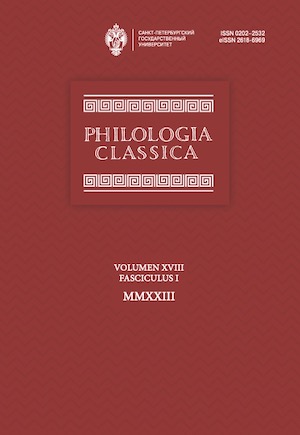Nec vero contemnendum vulgus interdum est: Vernacular animal names among Theodore Gaza’s Latin neologisms
DOI:
https://doi.org/10.21638/spbu20.2023.105Abstract
The article discusses the origins of four Neo-Latin animal names, denoting a beetle, a bird, a fish and a mollusk, coined by the Greek scholar Theodore Gaza in the third quarter of the fifteenth century: two neologisms of form, or proper neologisms, gal(l)eruca and gallinago, and two neologisms of sense, cernua ‘inclined forwards, head foremost’ and patella ‘plate, pan’. These words, still valid in today’s zoological nomenclature, were first introduced in Gaza’s Latin version of Aristotle’s Historia animalium, where they stood, respectively, for μηλολόνθη, σκολόπαξ/ἀσκαλώπας, ὀρφώς/ὀρφός and λεπάς. Apparently, they owe their existence to Gaza’s acquaintance with Italian dialectal vocabulary, as can be deduced from two sixteenthcentury sources: Agostino Nifo’s commentary to Aristotle’s zoological writings and Ippolito Salviani’s encyclopedic work on aquatic animals. Gaza’s galleruca must have originated from the Lombard galeruca ‘rose chafer’ (the identification of μηλολόνθη with the latter probably due to the hapax legomenon χρυσομηλολόνθιον, Ar. Vesp. 1341), gallinago from the Emilian gallinazza ‘woodcock’ (since the only known characteristic of σκολόπαξ/ἀσκαλώπας is that it is similar to a hen, Arist. Hist. an. 617b24), cernua from the Calabrian cerna/cernia (identified with ὀρφώς/ὀρφός either due to Gaza’s use of a bilingual glossary or due to his own experience in the Calabrian bilingual milieu) and patella from the Calabrian or Roman patella ‘pan; limpet’ (perhaps identified with λεπάς because Gaza kept in mind the name of a vessel, λεπαστή/λεπάστη, considered deriving from λεπάς by Eustathius). All the said dialects correspond to the Italian regions where Gaza spent parts of his life.
Keywords:
Theodore Gaza, Ippolito Salviani, Agostino Nifo, Neo-Latin neologisms, Italian dialects, zoological nomenclature, galeruca, gallinago, cernua, patella
Downloads
References
Downloads
Published
How to Cite
Issue
Section
License
Articles of "Philologia Classica" are open access distributed under the terms of the License Agreement with Saint Petersburg State University, which permits to the authors unrestricted distribution and self-archiving free of charge.






